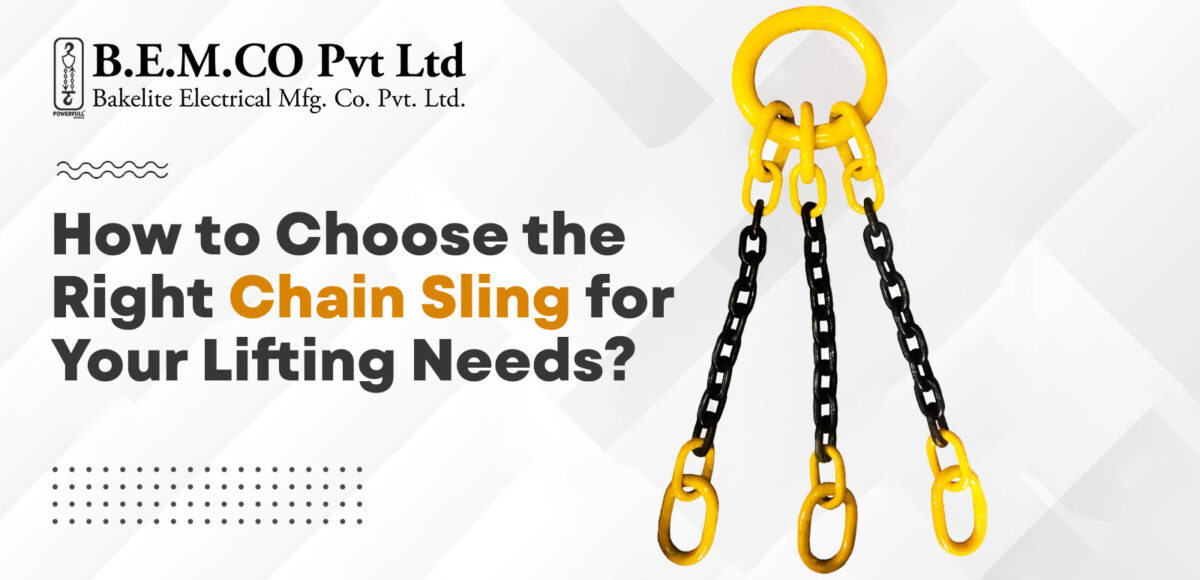
How to Choose the Right Chain Sling for Your Lifting Needs?
Choose our premium-grade chain slings for the best lifting solution for difficult jobs. They are made to withstand the most difficult lifting and rigging jobs, such as overhead lifting. Explore the variety of chain sling possibilities in this blog post and choose the one that best suits your lifting needs.
Chain Slings: What Are They?
Chain slings are lifting devices made to support large weights, especially in conditions when other slings might not be adequate. Chain lifting slings are composed of high-strength alloy steel and have a master oblong link that is attached to chains and different hook fittings. These slings perform exceptionally well in abrasive and heat-resistant environments and are designed for overhead lifting and rigging applications. Chain slings offer solutions for a range of lifting requirements across sectors, thanks to their varied configurations and end fittings.
The load’s weight and strength
The weight and strength of the load should always be taken into account when comparing various lifting sling types for your operations. A weight frequently falls and breaks, especially when it isn’t properly supported from the sides. When handling heavy cargo, use sturdy rigging and offer support in all directions. By offering assistance from the sides, people on the job site won’t fall and sustain accidents.
Flexibility of Slings
Alloy chain slings are known to be sufficiently flexible to be readily stretched by a large weight. It is also possible to stretch various kinds of lifting slings. This feature of lifting slings isn’t particularly appealing, but it helps change the center of gravity of the load. This adaptability keeps the load from sagging on one side, which is quite risky at work.
Temperature Limits
When selecting lifting slings, pay attention to their temperature restrictions. Lifting slings have been designed to withstand temperatures up to 1,000 degrees Fahrenheit. Anything above these temps might be disastrous. If you’re purchasing lifting slings to carry large gear and equipment in tough environments, make sure to verify the temperature specifications. The chain sling you pick should be capable of withstanding high temperatures without straining or melting.
Sling Ratings
The majority of available slings have industrial ratings, which indicate specified operating conditions. Temperature, load, operational circumstances, and how they are linked to the load are among the exact characteristics that will be provided. Make sure that the chain lifting sling you choose fulfills the sling ratings that are appropriate for your needs. If their ratings and your requirements do not match, it might be disastrous for your employees.
Wear and Tear-Resistant
Chain slings are subjected to extensive stretching and lifting of extremely high weights. As a result, indicators of tiredness, wear, and tear are a regular issue while utilizing lifting string. When choosing a lifting sling, look for one that can tolerate strain. You should choose a lifting sling that will not crack when bent by a short radius. Get a lifting sling that will resist wear and tear and last for several years.
Lifting Points
Before making a purchase, ensure that your lifting sling has appropriate lifting points on the load. There should be a means for attaching your slings to the cargo. Otherwise, you’ll need to figure out how to link the chain slings to your cargo. Check that the holes are large enough to support the whole weight of the load and avoid falls.
Conclusion
There are several types of lifting chain slings available to you. As a result, you must undertake a thorough investigation before picking which lifting sling to utilize. After carefully analyzing your requirements, you will easily find a lifting sling that suits them.

B.E.M. Co. Pvt. Ltd. (Bakelite Electrical Mfg. Co. Pvt. Ltd.).
Bakelite Electrical Mfg. Co. Pvt. Ltd. is a well-known Industrial Chain Pulley Block Manufacturer in India since 1959. Our lifting equipment is in high demand as they can easily lift heavy materials.
